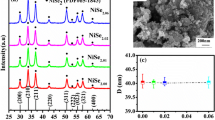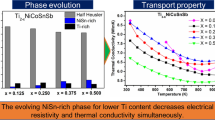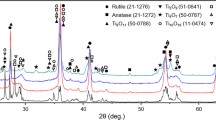Abstract
Nonstoichiometric TiO2-x compacts were obtained via spark plasma sintering of titanium dioxide powder. The thermoelectric properties of the resulting materials were examined at temperatures varying from 297 to 973 K. Nonstoichiometric TiO2-x compacts were formed and controlled by varying the sintering temperature during the spark plasma sintering process. The as-prepared compacts possessed oxygen deficiencies and various Magnéli phases TinO2n-1 (n = 4–9), because of the complex interplay between the sintering temperature and stoichiometry. The results demonstrated that the introduction of more and more oxygen deficiencies and the resultant formation of Ti4O7 positively affected the electrical resistivity, but also diminished the Seebeck coefficient. Additionally, an increase in the sintering temperature led to a higher reduction degree, causing a further increase in the number of oxygen deficiencies and enhancement of phase evolution and thermal conductivity. Consequently, the introduction of a moderate number of oxygen deficiencies is advisable in upgrading the thermoelectric properties of TiO2. The compact obtained at a sintering temperature of 1073 K displayed a reasonable thermoelectric efficiency (ZT) of 0.169 at 773 K. Furthermore, first-principles calculations demonstrated that the TiO2 band gap is narrowed by the introduction of oxygen deficiencies, and the electrons near the oxygen vacancy can easily break away from atoms, thus leading to the associated electron transition responsible for the significant decrease in electrical resistivity.







Similar content being viewed by others
References
Kurita D, Ohta S, Sugiura K, Ohta H, Koumoto K (2006) Cartier generation and transport properties of heavily Nb-doped anatase TiO2 epitaxial films at high temperature. J Appl Phys 100:096105. https://doi.org/10.1063/1.2362990
Liu H, Ma H, Wang F, Liu B, Liu B, Chen J, Jia X (2018) Further insights into thermoelectric properties of nonstoichiometric titanium oxide fabricated by high pressure and high temperature. Ceram Int 44:8043–8047. https://doi.org/10.1016/j.ceramint.2018.01.245
Miao L, Liu CY, Zhou JH, Zhang M (2013) Research and development of titania-based nanostructured materials for high performance thermoelectric applications. Adv new renew energy 1(2):115–130. https://doi.org/10.3969/j.issn.2095-560X.2013.02.001
Yang L, Chen Z, Dargusch MS, Zou J (2018) High performance thermoelectric materials: progress and their applications. Adv Energy Mater 8(6):1701797. https://doi.org/10.1002/aenm.201701797
Suhail MH, Mohan Rao G, Mohan S (1992) Dc reactive magnetron sputtering of titanium-structural and optical characterization of TiO2 films. J Appl Phys 71:1421–1427. https://doi.org/10.1063/1.351264
Howard CJ, Savine TM, Dickson F (l991) Structural and thermal parameters for rutile and anatase. Acta Cryst B47: 462–468. 10.1107/ S010876819100335X
Diebold U (2003) The surface science of titanium dioxide. Surf Sci Rep 48:53–229. https://doi.org/10.1016/S0167-5729(02)00100-0
He Q, Hao Q, Chen G, Poudel B, Wang X, Wang D, Ren ZF (2007) Thermoelectric property studies on bulk TiOx with x from 1 to 2. Appl Phys Lett 91:052505. https://doi.org/10.1063/1.2767775
Lee H, Han SJ, Seshadri RC, Sampath S (2016) Thermoelectric properties of in-situ plasma spray synthesized sub-stoichiometry TiO2-x. Sci Rep-UK 6:36581. https://doi.org/10.1038/srep36581
Andersson S, Collén B, Kuylenstierna U, Magnéli A, Pestmalis H, Åsbrink S (1957) Phase analysis studies on the titanium-oxygen system. Acta Chem Scand 11:1641–1652. https://doi.org/10.3891/acta.chem.scand.11-1641
Harada S, Tanaka K, Inui H (2010) Thermoelectric properties and crystallographic shear structures in titanium oxides of the Magnèli phases. J Appl Phys 108:083703. https://doi.org/10.1063/1.3498801
Itakura M, Niizeki N, Toyoda H, Iwasaki H (2014) Hall effect and thermoelectric power in semiconductive TiO2. Jpn J Appl Phys 6(3):311–317. https://doi.org/10.1143/JJAP.6.311
Thurber WR, Mante AJH (1965) Thermal conductivity and thermoelectric power of rutile (TiO2). Phys Rev 139:A1665. https://doi.org/10.1103/PhysRev.139.A1655
Liu H, Ma H, Su T, Zhang Y, Sun B, Liu B, Kong L, Liu B, Jia X (2017) High-thermoelectric performance of TiO2−x fabricated under high pressure at high temperatures. J Materiomics 3:286–292. https://doi.org/10.1016/j.jmat.2017.06.002
Tsuyumoto I, Hosono T, Murata M (2006) Thermoelectric power in nonstoichiometric orthorhombic titanium oxides. J Am Ceram Soc 89:2301–2303. https://doi.org/10.1111/j.1551-2916.2006.00979.x
Lu Y, Hirohashi M, Sato K (2006) Thermoelectric properties of non-stoichiometric titanium dioxide TiO2−x fabricated by reduction treatment using carbon powder. Mater Trans 47:1449–1452. https://doi.org/10.2320/matertrans.47.1449
Wang L, Li Z, Ohira S, Itoi T, Yoshida H, Lu Y (2021) Study on the fabricated non-stoichiometric titanium dioxide by in-situ reduction with carbon powder via spark plasma sintering. J Mater Sci: Mater Electron 32:24698–24709. https://doi.org/10.1007/s10854-021-06861-y
Hao L, Kikuchi Y, Yoshida H, Jin Y, Lu Y (2017) Magnèli phase TinO2n-1 bulks prepared by SPS followed by carbon reduction and their thermoelectric performance. J Alloy Compd 722:846–851. https://doi.org/10.1016/j.jallcom.2017.06.096
Lu Y, Matsuda Y, Sagara K, Hao L, Otomitsu T, Yoshida H (2012) Fabrication and thermoelectric properties of Magneli phases by adding Ti into TiO2. Adv Mater Res 415–417:1291–1296. https://doi.org/10.4028/www.scientific.net/AMR.415-417.1291
Fuda K, Shoji T, Kikuchi S, Kunihiro Y, Sugiyama S (2013) Fabrication of titanium oxide-based composites by reactive SPS sintering and their thermoelectric properties. J Electron Mater 42(7):2209–2213. https://doi.org/10.1007/s11664-013-2581-4
Gusev AA, Avvakumov EG, Medvedev AZH, Masliy AI (2007) Ceramic electrodes based on Magneli phases of titanium oxides. Sci Sinter 39:51–57. https://doi.org/10.2298/SOS0701051G
Japanese Industrial Standards JIS 1634:1998, Measurement method for density and porosity of sintered ceramics.
Walia S, Balendhran S, Nili H, Zhuiykov S, Rosengarten G, Wang QH, Bhaskaran M, Sriram S, Strano MS, Kalantar-zadeh K (2013) Transition metal oxides– thermoelectric properties. Prog Mater Sci 58:1443–1489. https://doi.org/10.1016/j.pmatsci.2013.06.003
Zebarjadi M, Esfarjani K, Dresselhaus MS, Ren ZF, Chen G (2012) Perspectives on thermoelectrics: from fundamentals to device applications. Energy Environ Sci 5:5147–5162. https://doi.org/10.1039/C1EE02497C
Soares GB, Ribeiro RAP, de Lazaro SR, Ribeiro C (2016) Photoelectrochemical and theoretical investigation of the photocatalytic activity of TiO2: N. RSC Adv 6:89687–89698. https://doi.org/10.1039/C6RA15825K
AtomWork Official Site. https://crystdb.nims.go.jp. Accessed 28 August 2021
Burdett JK, Hughbanks T, Miller GJ, Richardson JW, Smith JV (1987) Structural-electronic relationships in inorganic solids: powder neutron diffraction studies of the rutile and anatase polymorphs of titanium dioxide at 15 and 295 K. J Am Chem Soc 109:3639–3646. https://doi.org/10.1021/ja00246a021
PHASE is a program package for first-principles total energy calculations based on the density functional theory and the ultrasoft pseudopotential scheme, developed within the RISS project supported by MEXT of the Japanese government. For details, see the website http://www.ciss.iis.u-tokyo.ac.jp/rss21/en/index.html. Accessed 28 August2021.
First principles electronic state calculation software PHASE/0 2015 User Manual. http://azuma.nims.go.jp/software/phase/manuals. Accessed 28 August 2021
Asari Y, Nara J, Ohno T (2011) Theoretical study on diffusion mechanism of fluorine atom adsorbed on Si(111) reconstructed surface. Surf Sci 605:225–231. https://doi.org/10.1016/j.susc.2010.10.023
Perdew JP, Burke K, Ernzerhof M (1996) Generalized Gradient Approximation Made Simple. Phys Rev Lett 77:3865–3868. https://doi.org/10.1103/PhysRevLett.77.3865
Langhoff SR, Davidson ER (1974) Configuration interaction calculations on the nitrogen molecule. Int J Quantum Chem 8(1):61–72. https://doi.org/10.1002/qua.560080106
Pulay P (1980) Convergence acceleration of iterative sequences. the case of scf iteration. Chem Phys Letters 73(2):393–398. https://doi.org/10.1016/0009-2614(80)80396-4
Ribeiro RAP, Andre´s J, Longo E, Lazaro, SR (2018) A DFT investigation of the role of oxygen vacancies on the structural, electronic and magnetic properties of ATiO3 (A=Mn, Fe, Ni) multiferroic materials. Phys Chem Chem Phys 20:28382–28392. https://doi.org/10.1039/c8cP04443K
Tominaka S, Tsujimoto Y, Matsushita Y, Yamaura K (2011) Synthesis of nanostructured reduced titanium oxide: crystal structure transformation maintaining nanomorphology. Angew Chem Int Edit 50(32):7418–7421. https://doi.org/10.1002/anie.201101432
Mikami M, Ozaki K (2012) Thermoelectric properties of nitrogen-doped TiO2-x compounds. J Phys Conference 379:012006. https://doi.org/10.1088/1742-6596/379/1/012006
Sharma A, Gouldstone A, Sampath S, Gambino RJ (2006) Anisotropic electrical conduction from heterogeneous oxidation states in plasma sprayed TiO2 coatings. J Appl Phys 100:114906. https://doi.org/10.1063/1.2382456
Pandey SJ, Joshi G, Wang S, Curtarolo S, Gaume RM (2016) Modeling the thermoelectric properties of Ti5O9 Magnéli phase ceramics. J Electron Mater 45:5526–5532. https://doi.org/10.1007/s11664-016-4762-4
Varghese OK, Grimes CA (2003) Metal oxide nanoarchitectures for environmental sensing. J Nanosci Nanotechno 3:277–293. https://doi.org/10.1166/jnn.2003.158
Yang K, Dai Y, Huang B (2007) Understanding photocatalytic activity of S-and P-doped TiO2 under visible light from First-Principles. J Phys Chem C 111(51):18985–18994. https://doi.org/10.1021/jp0756350
Wu J, Wu X, Zhu F, Zhang Q, Qin S, Li Y, Lu A (2012) The electronic structures of Fe- and V-doped rutile TiO2 from first-principles calculations. Acta Petrologica et Mineralogica 31(2):441–446
Godby RW, Schlüter M, Sham LJ (1986) Accurate exchange-correlation potential for silicon and its discontinuity on addition of an electron. Phys Rev Letters 56(22):2415–2418. https://doi.org/10.1103/PhysRevLett.56.2415
Perdew JP, Levy M (1983) Physical Content of the Exact Kohn-Sham Orbital Energies Band Gap and Derivative Discontinuities. Phys Rev Lett 51(20):1884–1887. https://doi.org/10.1103/PhysRevLett.51.1884
Stampfl C, Van de Walle CG (1999) Density-functional calculations for III-V nitrides using the local-density approximation and the generalized gradient approximation. Phys Rev B 59(8):5521–5535. https://doi.org/10.1103/physrevb.59.5521
Acknowledgements
This work was supported by JSPS KAKENHI (Grant number JP19K05053), the China Scholarship Council, and the Research Project of Chengdu Technological University.
Author information
Authors and Affiliations
Corresponding author
Ethics declarations
Conflict of interest
The authors report no declarations of interest.
Additional information
Handling Editor: Catalin Croitoru.
Publisher's Note
Springer Nature remains neutral with regard to jurisdictional claims in published maps and institutional affiliations.
Rights and permissions
Springer Nature or its licensor holds exclusive rights to this article under a publishing agreement with the author(s) or other rightsholder(s); author self-archiving of the accepted manuscript version of this article is solely governed by the terms of such publishing agreement and applicable law.
About this article
Cite this article
Wang, L., Li, Z., Jiang, Y. et al. Nonstoichiometric TiO2-x obtained via spark plasma sintering: thermoelectric properties and first-principles calculations. J Mater Sci 57, 15213–15223 (2022). https://doi.org/10.1007/s10853-022-07555-4
Received:
Accepted:
Published:
Issue Date:
DOI: https://doi.org/10.1007/s10853-022-07555-4




